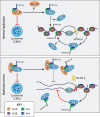Reduce, Retain, Recycle: Mechanisms for Promoting Histone Protein Degradation versus Stability and Retention
- PMID: 33753462
- PMCID: PMC8316141
- DOI: 10.1128/MCB.00007-21
Reduce, Retain, Recycle: Mechanisms for Promoting Histone Protein Degradation versus Stability and Retention
Abstract
The eukaryotic genome is packaged into chromatin. The nucleosome, the basic unit of chromatin, is composed of DNA coiled around a histone octamer. Histones are among the longest-lived protein species in mammalian cells due to their thermodynamic stability and their associations with DNA and histone chaperones. Histone metabolism plays an integral role in homeostasis. While histones are largely stable, the degradation of histone proteins is necessary under specific conditions. Here, we review the physiological and cellular contexts that promote histone degradation. We describe specific known mechanisms that drive histone proteolysis. Finally, we discuss the importance of histone degradation and regulation of histone supply for organismal and cellular fitness.
Keywords: DNA replication; chaperone; chromatin; histone; nucleosome; nucleus; posttranslational modification; transcription.
Figures




Similar articles
-
Histone chaperones: assisting histone traffic and nucleosome dynamics.Annu Rev Biochem. 2014;83:487-517. doi: 10.1146/annurev-biochem-060713-035536. Annu Rev Biochem. 2014. PMID: 24905786 Review.
-
Histone chaperone networks shaping chromatin function.Nat Rev Mol Cell Biol. 2017 Mar;18(3):141-158. doi: 10.1038/nrm.2016.159. Epub 2017 Jan 5. Nat Rev Mol Cell Biol. 2017. PMID: 28053344 Free PMC article. Review.
-
Fly Fishing for Histones: Catch and Release by Histone Chaperone Intrinsically Disordered Regions and Acidic Stretches.J Mol Biol. 2017 Aug 4;429(16):2401-2426. doi: 10.1016/j.jmb.2017.06.005. Epub 2017 Jun 10. J Mol Biol. 2017. PMID: 28610839 Free PMC article. Review.
-
The histone chaperoning pathway: from ribosome to nucleosome.Essays Biochem. 2019 Apr 23;63(1):29-43. doi: 10.1042/EBC20180055. Print 2019 Apr 23. Essays Biochem. 2019. PMID: 31015382 Free PMC article. Review.
-
Histones, histone chaperones and nucleosome assembly.Protein Cell. 2010 Jul;1(7):607-12. doi: 10.1007/s13238-010-0086-y. Protein Cell. 2010. PMID: 21203931 Free PMC article. Review.
Cited by
-
Cyclin E/CDK2 and feedback from soluble histone protein regulate the S phase burst of histone biosynthesis.Cell Rep. 2023 Jul 25;42(7):112768. doi: 10.1016/j.celrep.2023.112768. Epub 2023 Jul 9. Cell Rep. 2023. PMID: 37428633 Free PMC article.
-
Nucleosome assembly and disassembly pathways in vitro.PLoS One. 2022 Jul 13;17(7):e0267382. doi: 10.1371/journal.pone.0267382. eCollection 2022. PLoS One. 2022. PMID: 35830437 Free PMC article.
-
Atypical Ubiquitination and Parkinson's Disease.Int J Mol Sci. 2022 Mar 28;23(7):3705. doi: 10.3390/ijms23073705. Int J Mol Sci. 2022. PMID: 35409068 Free PMC article. Review.
-
UBR7 acts as a histone chaperone for post-nucleosomal histone H3.EMBO J. 2021 Dec 15;40(24):e108307. doi: 10.15252/embj.2021108307. Epub 2021 Nov 17. EMBO J. 2021. PMID: 34786730 Free PMC article.
-
Extracellular Histones Profiles of Pediatric H3K27-Altered Diffuse Midline Glioma.Mol Diagn Ther. 2025 Jan;29(1):129-141. doi: 10.1007/s40291-024-00754-6. Epub 2024 Nov 8. Mol Diagn Ther. 2025. PMID: 39514166
References
Publication types
MeSH terms
Substances
Grants and funding
LinkOut - more resources
Full Text Sources
Other Literature Sources
